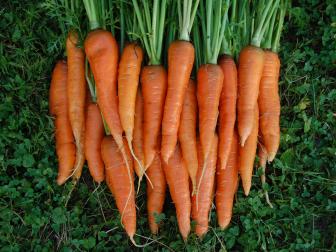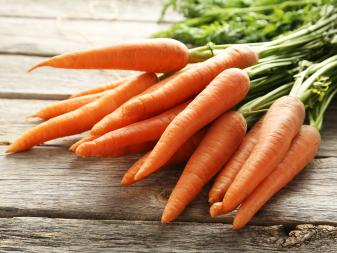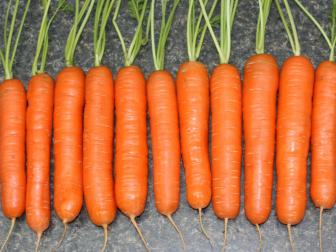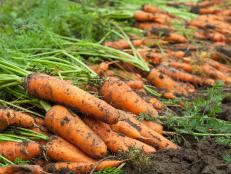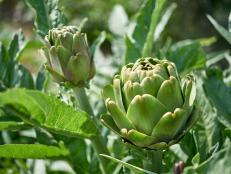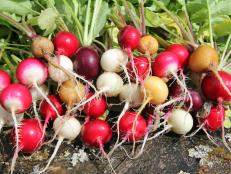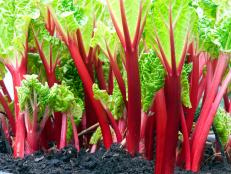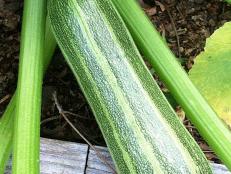How to Grow Carrots
The secret to growing beautiful carrots is in the soil. Follow these tips to start your carrot patch off on the right foot.

Whether you grow traditional orange carrots, or raise a rainbow of purple, red, white and red varieties, these crunchy, colorful veggies are fun to raise and good for you.
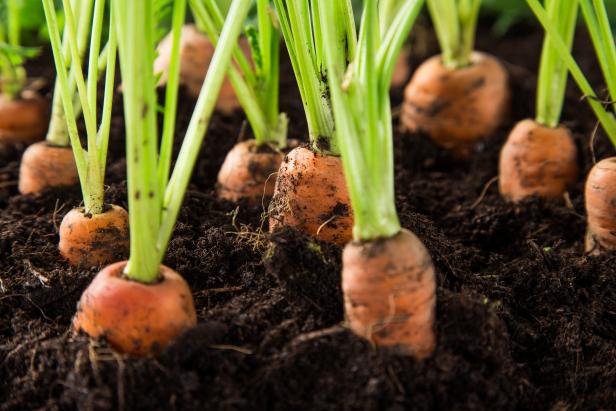
Shutterstock/Lukas Gojda
But they’re also tricky to grow. Carrots need deep, loose soil, and when they aren’t happy in the garden, their roots become stunted, twisted or forked.
Tips for Growing Carrots
Soil for Carrots
One of the secrets to growing great carrots is giving them the right nutrients. Start by testing your soil with a purchased kit, or, if your county extension service office offers testing, send a soil sample from your garden. Most offices will give you instructions, but in general, you’ll need to collect some dry or slightly moist soil from several spots in the garden, digging from 1 inch deep to as much as 6 inches deep in each spot. Mix the soil in a bucket and send in only the requested amount — two cups is usually enough. Be sure to tell the extension agent what you want to grow, and allow a few weeks for the results to be processed.
Companion Plants for Carrots
Carrots are one of the trickiest, but most rewarding, vegetables to grow at home. Try companion planting techniques for a more successful carrot crop this year.
Add the amendments your test indicates and work them in. Carrots love potassium, among other nutrients, so if your garden is lacking, work in some wood ash. Other common amendments include lime, manure or other organic matter and fertilizer. Stick to the amounts shown by your test; too much can do more harm than good.
Dig or till deeply to give these root crops room to develop. For varieties with long roots, work the soil 12 to 16 inches deep or choose shorter, stubbier types. All carrots need soil that is free of weeds, grass, rocks, sticks and other debris.
Another tip for success: Grow your carrots in a raised bed instead of the ground. If you keep your bed about 4 feet wide, you’ll be able to reach into it and avoid walking around your plants as they grow, which compacts the soil. In a raised bed, loosen the soil 8 or 9 inches deep, or as deep as you can go.
Planting Carrots
An ideal garden spot for carrots will also have well-drained soil with a pH of 6.0 to 6.8 and full sun for at least eight hours a day. Wait until the soil temperature is 70 to 80 degrees to plant, or at least until the soil temperature stays above 60 degrees.
Growing Carrots From Seed
Carrots dislike transplanting, so sow the seeds outdoors, about 1/8-inch deep, in rows spaced 15 inches apart.
An easy planting tip: Space the seeds along the ground and lightly rake the soil over them with your hand. Seeds should make light contact with the soil, so pat them down gently, and keep them moist.
But watch out. If you have heavy rains, your soil may become compacted and crust over as it dries out, preventing the seeds from germinating. If the seeds don’t sprout in two or three weeks, sow again. You can also use an old gardener’s trick to keep track of your carrot seeds, and mix some radish seeds with them. The radish seeds will come up first to help you remember where you planted.
What Are the Different Types of Carrots?
Learn about the five types of carrots and which ones will work best for your garden.
Once the seedlings are about 1 inch high, thin them to 2 to 3 inches, or as the seed packet indicates for your variety.
Don’t let your carrots become completely dry. Mulch with newspaper, weed block or even a light layer of grass clippings to help keep moisture in the soil and control weeds. When weeds appear, pull them by hand or cut them off at the soil line so you don’t disturb the carrots’ feeder roots.
Fertilize with a formula that promotes root growth, rather than one with a lot of nitrogen, which promotes foliage. A 5-10-10 formula with 5% nitrogen, 10% phosphate and 10% potassium is fine. Give the carrots about 1 inch of water a week.
Harvesting Carrots
When to Harvest Carrots
When to harvest carrots really depends on the variety that you are growing. It is important to look at the harvest dates when buying your seeds packets. Some carrots can be harvested at 58 days, while others are in the 75- to 100-day time period. After planting your seeds, make a reminder on your calendar or phone for the days until harvest stated on the seed pack. This will serve as one way of knowing when to harvest your carrot crop.
You don’t have to pull all your carrots at once. Leave some in the ground to stagger your supply of fresh veggies for the table.
Pulling some "test" carrots can also be a way of finding out if the carrots are at the size that is ready to harvest. Again, each variety will vary in shape and size, so it's best to keep your seed packed for reference. Consider organizing seed packets in a binder to track when to harvest, what size the end product should be and what varieties worked well in your garden.
Another way of telling that your carrots are ready to harvest is by looking at the diameter of the carrot. If it is between 3/4 to 1 inch in circumference, they are ready to pull. Some gardeners like pulling the carrots when they are immature as for roasting or adding whole to garnish salads. However, carrots are at their sweetest and best in flavor when they are fully grown and deepest in color.
How to Harvest Carrots
Harvesting carrots is quite simple. Gently pull at the top of the carrot that has emerged from the soil (not the leaves, but the root). This will help it loosen from the soil surrounding it. This can also be done quickly by using a garden fork or spade to loosen the soil around the carrots. Be careful not to pierce any of the vegetables.
Once the soil has been loosened, grab the carrot by the greens or at the top of the carrot if exposed. Firmly pulling the carrot should remove it from the soil easily. Once free from the soil, shake off any excess dirt.
Carrots can be harvested well into the fall. However, it is important to pull all carrots before the ground freezes. In some climates, where the ground does not freeze solid and the temperature stays above freezing (32 degrees), carrots can be grown and harvested in the winter months.
Insulating around the crop with straw is necessary to keep the crop growing. It is important to keep in mind that this biennial will bolt in the spring. The bolting (or flowering) will ruin the flavor and texture of the taproot but it will be wonderful for beneficial insects in the garden. Most gardeners will plant carrots in the spring months for harvest in summer.
Carrot Varieties to Try
- ‘Red-Cored Chantenay’ – Recommended for heavy or clay soils, these carrots grow about 6 inches long and are crisp and tender.
- ‘Scarlet Nantes’ – Flavorful and mild, this carrot grows to 16 inches. Harvest the roots while they’re immature for a sweet, tender flavor.
- ‘Short 'n Sweet‘ – Bred for poor soils, these 4-inch long, bright orange carrots can be grown in containers and mature in about 68 days.
- ‘Thumbelina’ – This All-America Winner is great for snacking and growing in containers. Harvest the carrots in about 70 days, or when they are about the size of golf balls.
- ‘Purple Dragon’ – This sweet, eye-catching carrot has a purple skin and a yellow-orange core. Shred it into slaws and salads to enjoy the colors.
- ‘SugarSnax’ – Disease-resistant ‘SugarSnax’ forms 9- to 10-inch tapered roots. They’re smooth and deep orange in color.
11 Unusual Carrots to Grow 12 Photos
These nutritious root veggies come in all shapes and sizes — and they're not just orange.
Carrot Recipes from Food Network
Get Food Network's best carrot recipes, a list proving the carrot is a delicous and versatile veggie.

.-Battle-on-the-Beach-courtesy-of-HGTV.-.jpg.rend.hgtvcom.196.196.suffix/1714761529029.jpeg)




